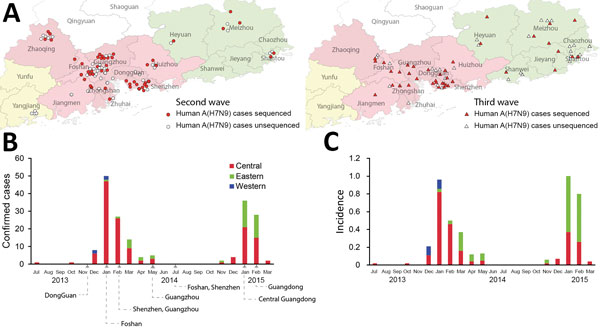Effect of Live Poultry Market Interventions on Influenza A(H7N9) Virus, Guangdong, China
Jie Wu
1, Jing Lu
1, Ester C. Sabino
1, Xianqiao Zeng, Yingchao Song, Lirong Zou, Lina Yi, Lijun Liang, Hanzhong Ni, Min Kang, Xin Zhang, Guofeng Huang, Haojie Zhong, Thomas A. Bowden, Jayna Raghwani, Jianfeng He, Xiang He, Jinyan Lin, Marion Koopmans, Oliver G. Pybus, and Changwen Ke

Author affiliations: Guangdong Provincial Center for Disease Control and Prevention, Guangzhou, China (J. Wu, J. Lu, X. Zeng, Y. Song, L. Zou, L. Yi, L. Liang, H. Ni, M. Kang, X. Zhang, G. Huang, H. Zhong, J. He, X. He, J. Lin, C. Ke); University of Oxford, Oxford, UK (J. Lu, N.R. Faria, T.A. Bowden, J. Raghwani, O.G. Pybus); Erasmus Medical Center, Rotterdam, the Netherlands (M. Koopmans)
Main Article
Figure 1

Figure 1. Avian influenza A(H7N9) infection in humans, Guangdong, China, 2013–2015. A) Geographic distribution of H7N9 in humans during the second (June 2013–May 2014) and third (June 2014–May 2015) waves. Confirmed cases in humans identified during the second wave are marked with circles and during the third wave with triangles. H7N9 isolates newly sequenced in this study are highlighted in red. Pink and green shading indicates city prefectures in central and eastern Guangdong Province, respectively. B) Numbers of human H7N9 infections in different regions of Guangdong Province during 2013–2015. Arrows indicate the dates at which live-poultry markets were closed in epicenter cities. No infections were reported during April–October. C) Incidence (human H7N9 infections/1 million population) in each region.
Main Article
Page created: November 17, 2016
Page updated: November 17, 2016
Page reviewed: November 17, 2016
The conclusions, findings, and opinions expressed by authors contributing to this journal do not necessarily reflect the official position of the U.S. Department of Health and Human Services, the Public Health Service, the Centers for Disease Control and Prevention, or the authors' affiliated institutions. Use of trade names is for identification only and does not imply endorsement by any of the groups named above.
